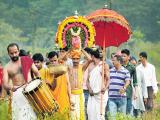Bhagwathy Namme is one of the important village temple festivals in Kodagu. It happens at different times of the year in various goddess temples. One such temple is Arapattu Bhagwathy Temple, which is supported by the dand keri (two hamlets) of Arapattu and Poddavadi.
In the past, Bhagwathy and Vishnu Murthy shrines of this region used to be managed by the extended family members of Mukkatira Roy Biddappa of Arapattu village. But now a village committee is responsible for the temple management.
According to Kanniyada Prakash, secretary of Arapattu Bhagwathy Temple, “The Bhagwathy goddess came to Kodagu from Soli village accompanied by Vishnu Murthy and the assistant god Mandana Murthy along with the Banna, Maleya and Pale communities, and my Kanniya family, who are astrologers. The Kanniya were given farm land and settled in Arapattu. They perform the ceremonies at the Mandana Murthy shrine. The anji koot murthy (five spirits) and the patt koot patala (ten protectors) are also given place in the shrine.”
Normally, wherever a temple was built for Bhagwathy, a shrine was also dedicated to Vishnu, in the Vishnu Murthy form, and his five companion spirits. The five spirits are also called the kootali, bodyguards or companions, of Vishnu Murthy. They are Kutti Chatta, Kala Bhairava, Kari Baala, Kuliya, also known as Gulika, and Nuchchute.
Mukkatira Changari, a member of the village temple committee, says, “From the seventh until the eleventh day of the Fish month (called Minyaar, or Pisces), every morning and evening, dance and song programmes are organised in the name of the goddess, and special light arrangements are done.”
On the seventh day of the month, the villagers get together and observe a special fast. Fines for deviations from ritual observances are paid. The main puja is held in the evening.
A temple priest carries the idol upon his head and dances. On the ninth day, the astrologers meet the villagers at the temple in the evening. Then they all go to the shrine of Mandana Murthy. On the tenth day, every family from the two villages bring fine rice on the backs of oxen and offer it to the goddess. On the eleventh day, which is the last day of the feast, lunch is offered at the temple.
A member of the temple priest’s family wears priestly robes and carries the Bhagwathy idol, called the thadamb, upon his head. Also Bidderianda Satish, a designated native called the thiralekara, wears the traditional white kuppya chele costume and dances the thirale (whirl) before the idol. He also behaves as an oracle, answering to the queries of devotees.
Late in the afternoon, the idol is taken across the fields by devotees to the stream to be washed. Then the idol is brought back and taken around the temple. While taking the idol around the temple, the carrier also dances on his feet, all the while holding the thadamb upon his head. After this, coconuts hung up in the air are shot at with guns. Finally the priests serve a vegetarian feast to the devotees.
source: http://www.deccanherald.com / Deccan Herald / Home> Supplements> Spectrum / Mookonda Kushalappa / February 07th, 2017


